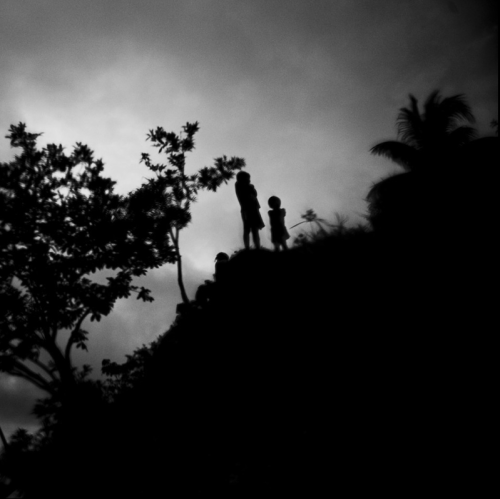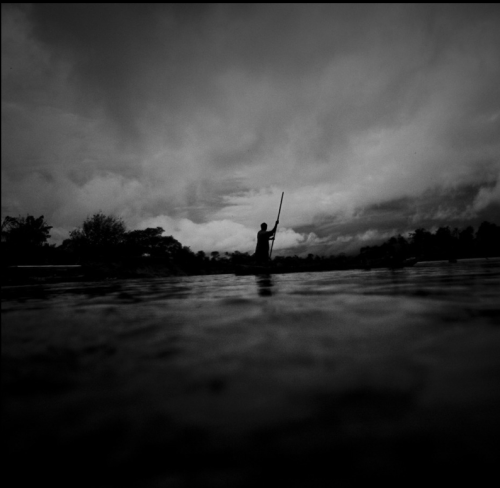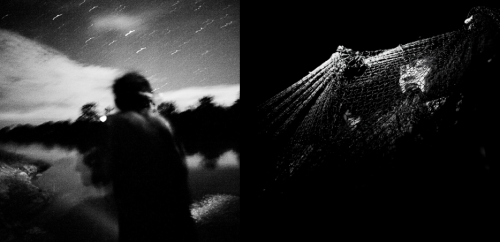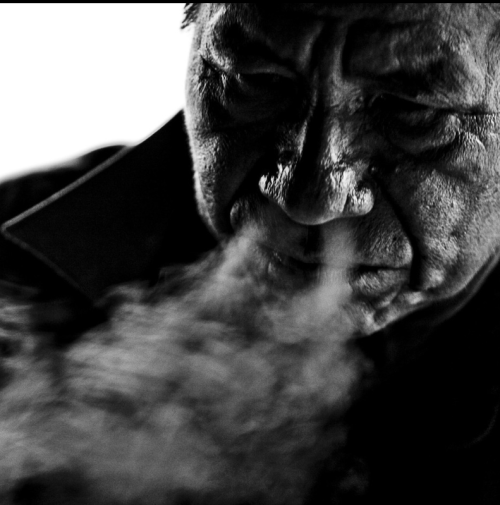#indigenous land
Musuk Nolte: Shawi (Peruvian Amazonas)
Artist Statement: Shawi is the name of an indigenous group inhabiting a spit of land in the Province of Alto Amazonas, in the depths of the Peruvian jungle. Even when living two days away from the closest city, over the course of centuries, they have lived in complete isolation, resisting and holding out against the indifference and ignorance of the Peruvian State.
In the late nineteenth century people came to extract rubber from their trees, in the twentieth, they cut them down to use their timber and since then, they come for the oil beneath their feet. Nevertheless, because of their striving, the Shawi people have managed to keep more territory than other indigenos groups and they have become throughout the years a symbol of the indigenous communities’ struggle to preserve their land from the ever-growing interest in exploiting its rich natural resources.
They are one of the least studied groups living in the Amazon Rainforest, however, one of the largest in number, with 13,000 inhabitants scattered through the jungle. They bare an ancient way of unabridged coexistence with the forest, by learning about their mystical powers guided by shamans. These shamans foster Shawi’s religious magic by developing their knowledge of plants and have always been highly respected in the Amazonian legends because of their voluntary isolation. Many of these important lessons are disclosed when speaking Ayahuasca. The initiation ceremonies for the taking of Ayahuasca are carried out between the headwaters of the Paranapura and Sillay rivers since before the Inca period. It is a vine that has psychotropic properties which enable communication with the spirits of the forest.
Post link
[ID:
The video starts off with a picture of “The Eye of Fire”, or where a fire opened up on the surface of the Gulf of Mexico.
There’s white text above it stating “the Gulf of Mexico is on fire because of a pipeline rupture wtf” with four question marks.
The video switches to a person.
“So we have to talk about Line 3, again. Line 3 is being illegally built through sovereign Indigenous territory.”
Behind them shows a map of said territory.
“Not only this but it (Line 3) has the possibility to pollute over 200 bodies of fresh water and will put out the same amount of emissions as 50 coal plants”
The screenshot at the back says: “It’s the spills — which always happen with pipelines. It’s the disruption itself of just the pipeline going into 800 wetlands, 200 bodies of water. Then there’s the climate change piece, emissions of this 50 coal plants, absolutely insanity,” a quote from attorney Tara Houska of Couchiching First Nation who is the founder of the advocacy organization Giniw Collective. This came from a interview with CNN in March.
“This violates Indigenous treaty,” the person says as another screenshot pops up.
It says, as a quote from Aubid, one of many Indigenous climate activists: “The Line 3 extension would also cross through the Leech Lake and Fond Du Lac reservations — land where, according to the terms of a 1855 treaty, Ojibwe tribes have the right to gather, hunt, and fish. For this reason, Anishinaabe activists say the pipeline violates the terms of the treaty.”
The article from MSN News continues: “What is spelled out in the treaty — the pipeline could pollute food sources, water sources, everything spelled out in the treaty what we as Anishinaabe people can do — hunt, fish, gather food, medicine. Line 3 goes against what we do spiritually as people,”
A picture of Indigenous activists with a couple of signs, one says “Honor our treaties, #StopLine3”.
“Currently Indigenous water protectors are being arrested,”
“We don’t have time to argue. The ocean is on fire. Entire towns are burning to the ground because of the climate crisis. Building another pipeline right now, especially when it’s going to bring more violence to Indigenous communities is only going to hurdle us faster towards climate disaster.”
A tweet that originally shows the same picture in the beginning from a verified account (Brian Kahn) that says “The Gulf of Mexico is literally on fire because of a pipeline rupture”, continues with another verified account (Dallas Goldtooth) retweeting it, “THIS IS WHY @.POTUS MUST STOP Line 3 — Shut down DAPL and end all climate-destroying fossil fuel projects”.
“If you don’t want this happening, in some of the only lakes in the country that provide us freshwater, during one of the biggest heatwaves of the century, then fight with Indigenous people against this pipeline. Against Line 3. Go to the site linked and sign the petition. Educate yourself. Tell others.”
The petition they were talking about is here: StopLine3
END]
[ID:
The audio starts with singers and drums in the background. An audio clip starts of a Canadian member of parliament speaking on the issue of the Trans Mountain pipeline project. This audio is from 2018.
“-and his minister adds that Canada will not be able to accommodate all Indigenous concerns. What thats means is that they have decided to willfully violate their constitutional duties and obligations.”
The speaker, Romeo Saganash, a Cree Lawmaker, continues.
“Mr Speaker, sounds like a most important relationship, doesn’t it? Why doesn’t the prime minister just say the truth and tell Indigenous people’s that he doesn’t give a fuck about their rights?”
The video is of a person leaning down to the camera (in a small area of grass and trees) before turning their back to it and dancing at the end of the video with orange text stating in all caps
“WE’RE COMING FOR EVERYTHING OUR ANCESTORS WERE DENIED”.
END]
[ID:
Person appears holding a bundle of furs.
“Hi! My name’s Siqiñiq, I am Iñuipaq from Alaska, Iñuit, and I want to show you my furs!”
They shift the furs in their arms, holding up a white with blue undertone fur.
“This is blue fox, I’m going to use this on my girl’s parka’s (atigi)”
They hold up a white and brown colored fur.
“This is lamb, which in the city many of us use as liners.”
They next switch to a caramel colored outfit.
“This is sikshrik, squirrel. This is what you would use as a liner traditionally. It’s much softer, so pretty.”
The next fur is a white-grey color.
“This is silver fox, my favorite.”
The Tiktoker holds up the finale fur.
“And my wolf!”
They wrap the wolf fur around their head.
“Okay, yesterday Biden signed support in one of the largest fossil fuel projects in North America right next to my village where my mom lives right now-“
White text that says “Willow Master Project” shows up. They put the fur down and bend closer to the camera.
“-a dynamite mine less then 10 miles away would be installed over 300 miles of pipeline. This completely goes against the Paris climate agreement.
You can take action now.
Visit the link in my profile, it’ll go to a YouTube video of testimony’s of real people in these communities. Then go to silainuat.org
Thank you!”
The video stops
END]
[ID:
Person slides into view.
“Hey everyone, it’s Xochitl back again with another Nahuatl lesson.” The sparkles emoji pops up with text saying “Happy Mother Language Day”.
“It’s international Mother Language Day, so what better to celebrate by paying tribute to my and probably your mother language, Nahuatl.”
Greenscreen opens up to map. “So many words we know today come from Nahuatl.”
“Nahuatl is the most widely spoken Indigenous language in North America. It belogs to the Uto-Aztecan family of language. It’s related to the Huichol language of Nayarit, the Yaqui and Tarahumara of Chihuahua, the Hopi of Arizona, and the Shoshone Indigenous language of Wyoming.”
“The Nahuatl language experienced it’s Golden Era in the 15th and early 16th century. During this time, the Nahautl language spread from Western Mexico to the Gulf Coast and even parts of Central America.”
Picture in background changes to a art recreation of a Nahuatl city, with the three names of the greatest cities, Tenochtitlan, Tetzcohco, and Tlacopan.
“These theee cities right here are the greatest empires of the Mexica People.”
New picture pops up of an ideogram of Nahuatl language.
“This right here is pictographics script, which is how the Mexica People used to communicate and write down their Nahuatl language. To this day, along with written manuscripts in Spanish, that’s how we preserve the Nahuatl classical language.”
END]
[ID:
Video opens up to uncut beluga meat on a wooden cutting board, gently zooming in with an ulu at the side. It zooms out to show soy sauce collected in a white with red rimmed bowl. Another person slowly starts cutting off the raw beluga fat from the beluga skin
“Yes, this is beluga. Our favorite traditional meal, called mattak. We eat it with soy sauce, and we use this traditional knife called ulu.”
“We cut off the fat. We make sure to cut it in small pieces because it’s hard to chew, it has a rubbery texture.”
Video shows the beluga meat being diced, still connected to the skin. Person dips the mattak into soy sauce and eats it.
The person recording holds up a big and thin piece of dried caribou, turning the camera to themself as they eat it.
“And this is dried caribou, called nikkuk. It’s delicious. All of these animals are hunted by our people, family, friends, and we feed to the whole community so it’s completely—“
The audio cuts off with white text clarifying, “The animals lived a happy natural life, we do not waste any part of the animal. We need to STOP the stereotypes of this being “cruel” and “inhumane”. This is the best way to hunt food.“
Screen switches to the Tik Toker’s name and username, Shina Nova / @shinanova
END]
[ID:
Person appears holding a bundle of furs.
“Hi! My name’s Siqiñiq, I am Iñuipaq from Alaska, Iñuit, and I want to show you my furs!”
They shift the furs in their arms, holding up a white with blue undertone fur.
“This is blue fox, I’m going to use this on my girl’s parka’s (atigi)”
They hold up a white and brown colored fur.
“This is lamb, which in the city many of us use as liners.”
They next switch to a caramel colored outfit.
“This is sikshrik, squirrel. This is what you would use as a liner traditionally. It’s much softer, so pretty.”
The next fur is a white-grey color.
“This is silver fox, my favorite.”
The Tiktoker holds up the finale fur.
“And my wolf!”
They wrap the wolf fur around their head.
“Okay, yesterday Biden signed support in one of the largest fossil fuel projects in North America right next to my village where my mom lives right now-“
White text that says “Willow Master Project” shows up. They put the fur down and bend closer to the camera.
“-a dynamite mine less then 10 miles away would be installed over 300 miles of pipeline. This completely goes against the Paris climate agreement.
You can take action now.
Visit the link in my profile, it’ll go to a YouTube video of testimony’s of real people in these communities. Then go to silainuat.org
Thank you!”
The video stops
END]
15% off our entire store until 12/5. etsy.com/shop/demiandineyazhi. All proceeds are channeled back into Indigenous communities and help find @riseindigenous’s annual artist and poetry fellowship. #cybermonday#buynative#qtpoc
Post link











